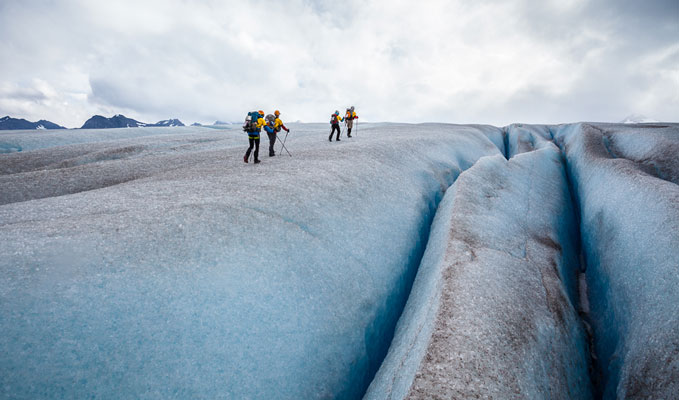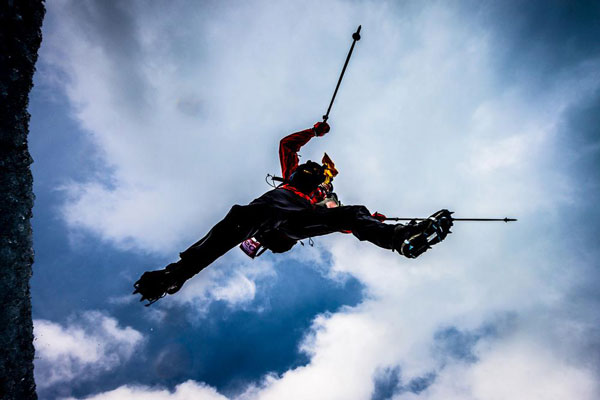Tom Grundy's Patagonia Expedition Race 2013 Trip Page
At the end of January I headed down to South America with Sam and Raquel to take part in the Patagonia Expedition Race. Getting down to Punta Arenas with all of our gear was quite the adventure which is detailed elsewhere. This page is about our experience with the race. Some of this text was previously posted on my blog, but it has been edited and at least some of the pictures are new. I plan on getting more pics posted when I get the pics from the other cameras. Most of the pics here are ones I took, others are from the rest of the team as well as a few from the PER (Patagonia Expedition Race) photographers. I will try to identify them.
We were competing with Taz as team Four Continents. This was Taz's 3rd year in the race and Sam was on his team last year. Raquel and I had only been in one other adventure race before this, the Bend 36 hour one. This was the 10th????? running of the Patagonia Expedition Race and would involve biking, trekking, and sea kayaking. The biking was almost all on dirt roads and I have done plenty of trekking, so the sea kayaking was the only event that I didn't feel confident in. The biggest worry for me was the pace required. I am not particularly fast and there were plenty of cutoff times that we would have to make. Last year the team essentially ran out of time after 6 days, although there were some other circumstances that led to the end of their race. Sam assured me that as long as we kept moving we would be ok.
Taz and I went to the meeting where they passed out the maps and described the route (they only let 2 people per team attend). The race would involve 700 Km of biking, trekking, and paddling from Puerto Natales to Punta Arenas. Mostly it would be biking and trekking. After the meeting we tried to determine how long each of the legs would take and how much food and other gear we needed to stash in each of the drop boxes. This was mostly an exercise in guessing. I was mostly going on a lean food ration and Taz had a slower (probably more realistic) time frame. Unfortunately his time had us missing the cutoff times (so there was no point in carrying that much food). Finally we had that sorted out as best we could and spent a lot of time looking at the maps and Google Earth aerial photos to attempt to figure out the best route and strategy (did we want to carry the pack rafts? - and if so, where).
The race was going to start at midnight in Puerto Natales with a 108 km mountain bike leg into the Torres Del Paine national park. We walked down to the Plaza Del Armas in Punta Arenas where all the teams were meeting. We had decided to take the pack rafts for one leg, so I was busy constructing hand paddles for them. All of the teams assembled in the square where photos were taken and speeches made. Then we boarded a bus to Puerto Natales. I don't know if they did it on purpose, but I thought it was interesting that they played "Hunger Games" on the video. I saw a few guanaco and rhea out the window as well as a condor. I tried to sleep, but I have never been good at sleeping in the day.
In Puerto Natales we were in a school auditorium where we assembled our bicycles and finished any final preparations. The YogaSlacker/Gear Junkie team was dismayed to find that their first food bin wasn't there (they had been told all of their food bins would be there for any final food swaps). We had a bit extra we gave them for the first leg. We joked that we were the control group testing if training helped - they trained, we didn't. Actually I had done a fair bit of training since I found out I was going to do this in late November. I had done some sort of cardio training nearly every other day since then (until the last few weeks at least). I wasn't in great shape, but I wasn't "off the couch" either. We went to a restaurant for a tasty pasta "last supper" and then headed back to the auditorium for more last minute gear/food things, napping, and getting measured by some physiologists doing a study. The clock slowly approached midnight. Around 11:30 we all assembled and biked over to the square where we would start. There was a bit of a party atmosphere at the square with loud music and a number of locals hanging out. Finally it was time to line up for the start. There was a countdown and then we were off.
preparing for the start in Puerto Natales
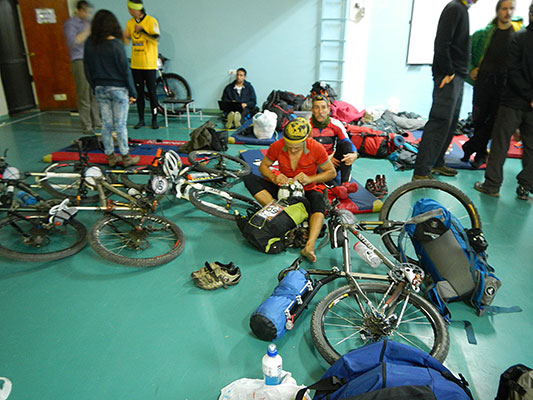 |
Puerto Natales, getting close to the start of the race
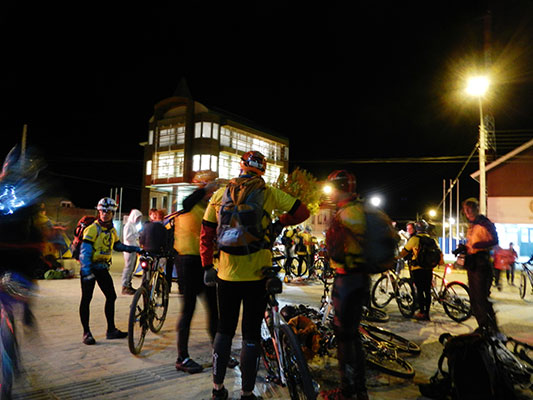 |
The plan was to stick with the lead pack as long as we could but almost immediately the team got split up and by the time we were back together we had lost the lead group. The lead group was led out of town but we were on our own and hit a confusing split. Another team headed left but I was dubiously checking the map when they came back - right it was. We continued on through the dark near some other teams ´til a flat tire put us in the very back. The fix was complicated by the fact that it was a tubeless tire and we couldn´t get the valve stem out easily to put in a tube. Back on the bikes we forged on, eventually passing one team. The km were sort of like monopoly miles. We had 108 total to go. Things got rougher around nautical twilight as we started up a series of hills. We were going too slowly. Not being able to train as a team before this really hurt us as we didn't do a good job of pacing each other. As dawn broke and we neared the park entrance the view was spectacular, but we needed to pick up the pace if we were to make the 8:30 cutoff. We started towing on the levels and slight grades and managed to pick up our pace to where we would probably make the cutoff, but at the cost of our legs. The sunrise on the mountains was really nice looking and I would love to have time and my dslr to take pics, instead we had to keep moving. The road was getting bumpier and bumpier too which really slowed us down. When we crossed a long paved bridge it felt so smooth and fast but then we bumped back to a crawl back on the dirt. With about 20 minutes left it looked like we would make it when Taz bonked. I stopped to help draft him, but he was too unsteady. With the tow rope we were back up to a ¨barely make it¨pace when we hit a hill. We walked the bikes up as fast as we could. I was almost cramping up. Then a nice downhill and a level run to the checkpoint that was 1.4 km farther than my bike odometer suggested. Taz asked if we could slow down, but the answer was an emphatic "NO". We made it to checkpoint 1 (CP 1) with only 57 seconds to spare. Then Sam and I collapsed into useless heaps.There were 2 other teams at the transition when we got there but they left before we did. One team didn't make the bicycle cutoff - it was the team we had passed and later some of them took a wrong turn in the park.
working on the flat tire (Sam? pic)
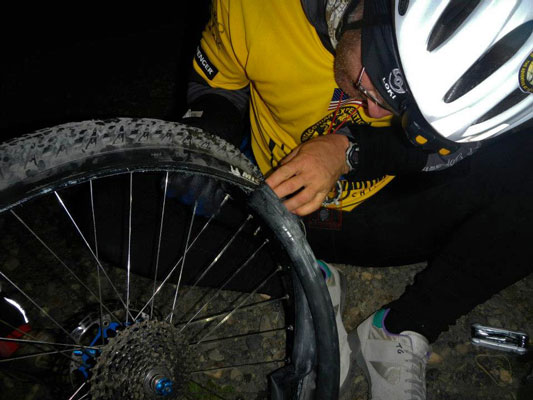 |
we still had a long way to go as it began to get light
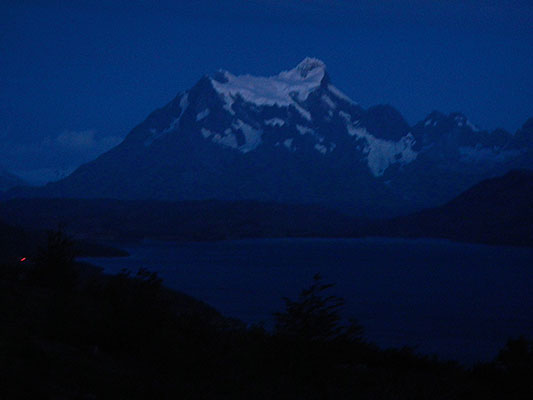 |
Torres Del Paine is pretty spectacular
this was my last chance to take a pic before the final push to CP1
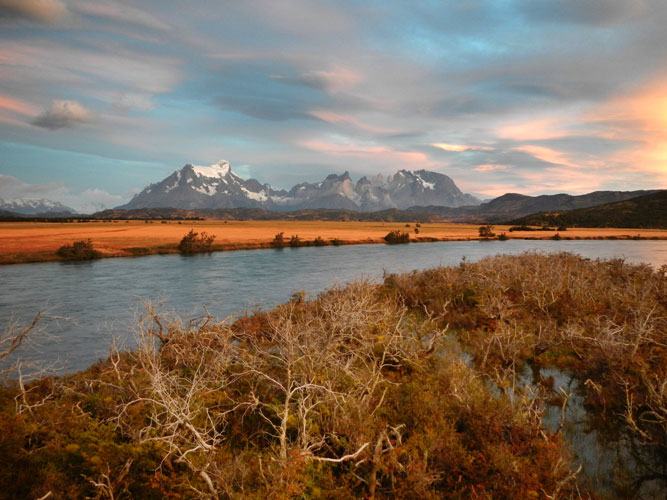 |
Sam heads down the road (Taz pic)
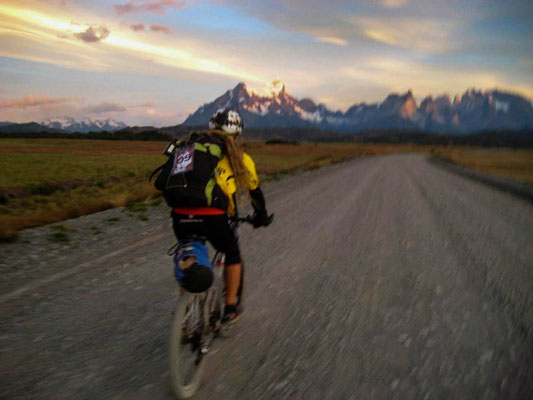 |
towing fun (Sam? pic)
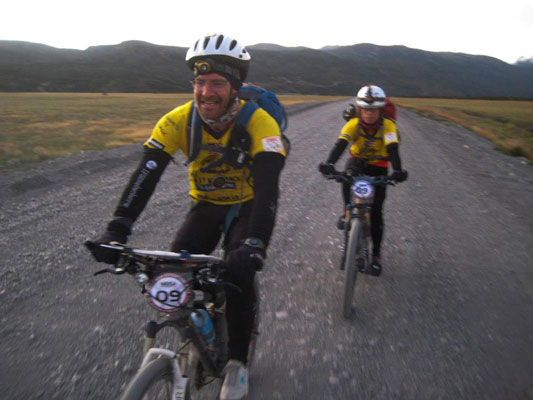 |
The transition took us just over an hour and with some food and drink Taz had recovered. We loaded up the packs and set off up the trail. The first 13 or 14 km were on a trail and then we headed cross country with a stream crossing and some scrambling up over and around one peak and then up to another ridge next to the glacier. We ended up walking along the edge of the glacier to the next checkpoint. We got to checkpoint 2 with a whopping 38 minutes to spare. We weren't going fast, but we were moving ok and had actually passed another 2 teams.
Taz near the start of the trekking
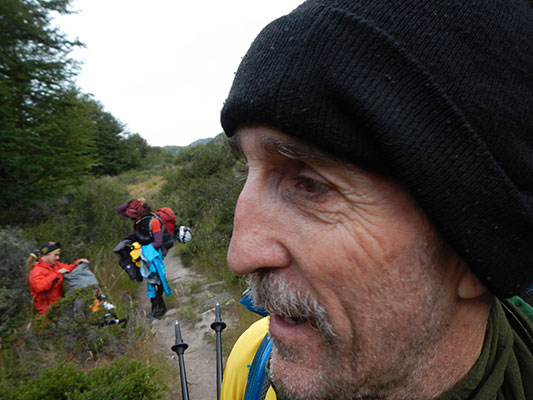 |
when the clouds lifted we had some nice views
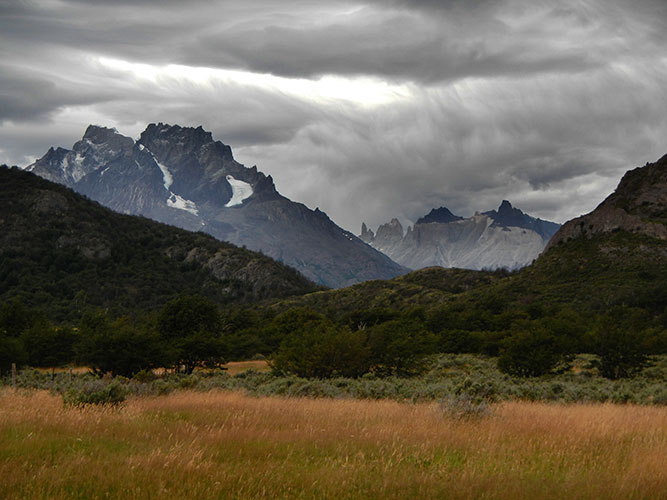 |
tired trekkers (Sam pic)
 |
got to keep moving (Sam? pic)
 |
Raquel trekking along
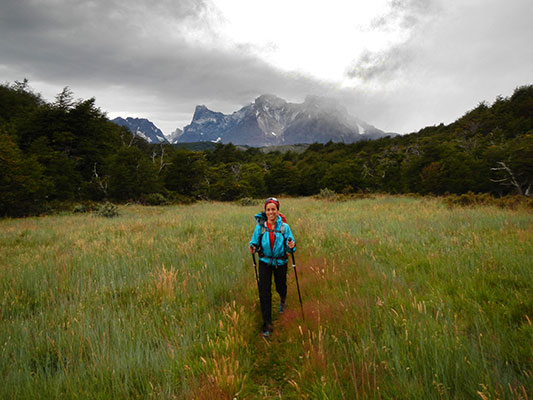 |
Sam taking a break
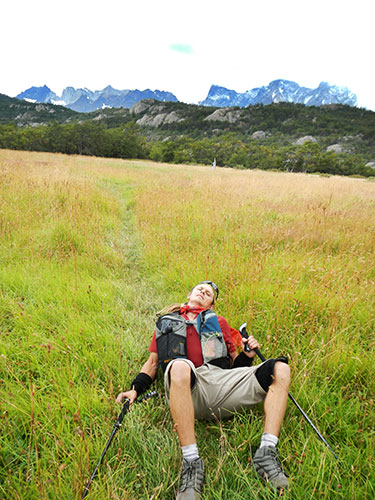 |
back on our feet (Taz pic)
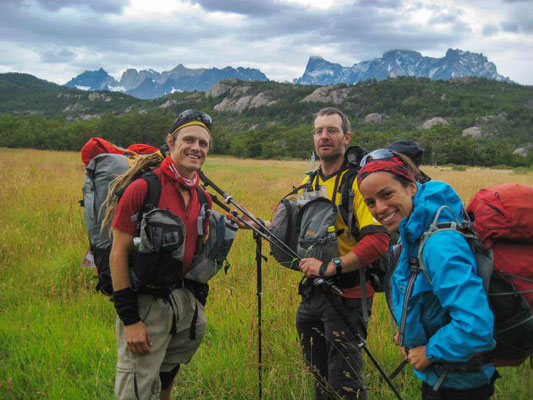 |
Taz worried about the time and our lack of progress
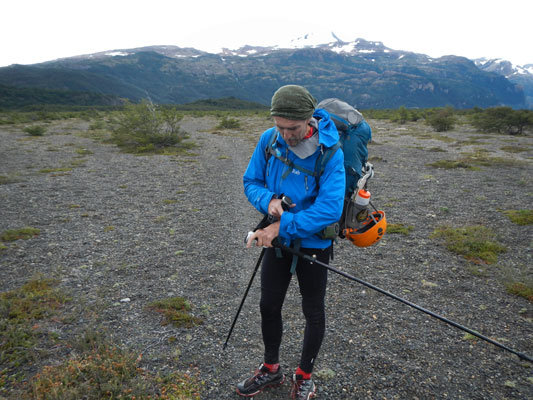 |
a stream crossing (Raquel is downstream of me) (Taz? pic)
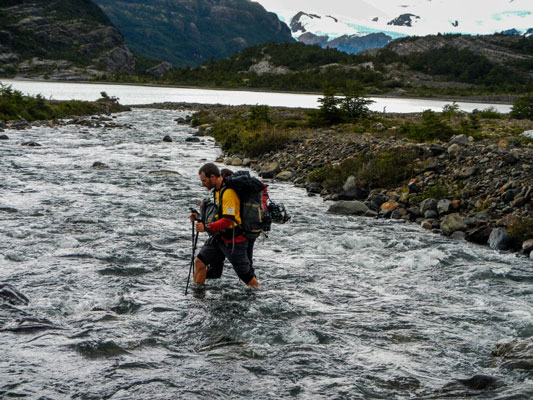 |
Raquel and Sam heading cross country
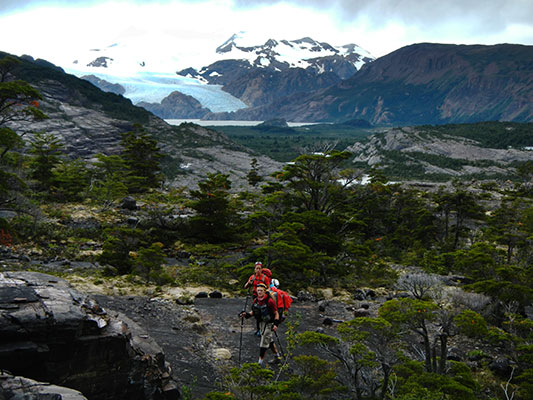 |
we headed down between the lakes and then up onto the shoulder of the ridge
and then left. We could see other teams scrambling ahead of us from here.
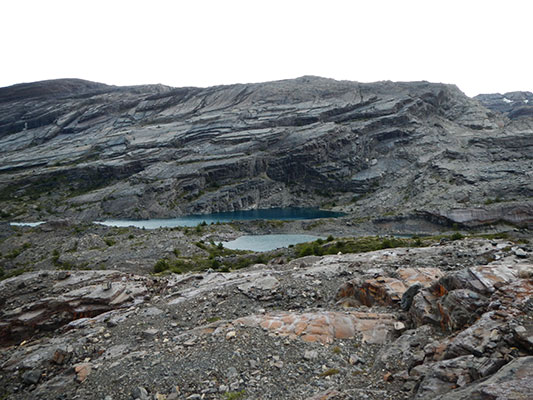 |
scrambling up (Sam? pic)
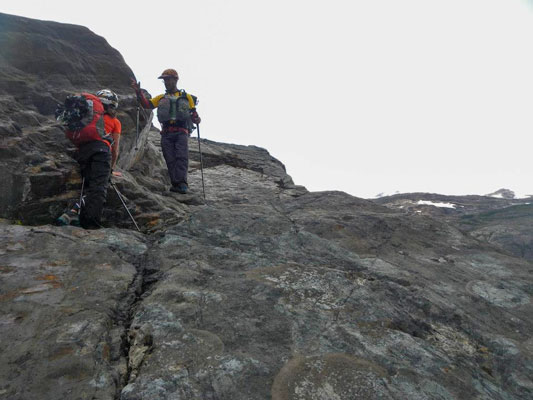 |
Sam and Raquel heading up onto that ridge
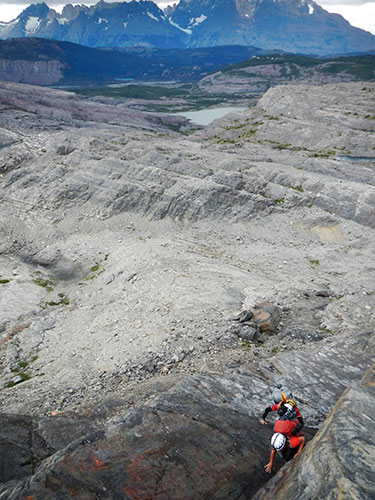 |
We strapped on our crampons and headed out onto the Tyndall Glacier. This was a 10 km crossing (this was just on a tongue of the great southern ice field, but it was still massive). It was just ice, no snow, so there was little risk of falling into a crevasse by surprise, but if the crevasse was wider than we were willing to jump we had to go around it. There we also streams and dolines (holes where the water dropped into the depths of the glacier). When we started weaving around crevasses we were going much farther than the 10 km straight line. Then we hit a more smooth patch and made good time. Unfortunately it was also getting dark, and starting to rain, and the wind was picking up. Some gusts were strong enough to knock us off balance - I am guessing up to 60 mph. We were all very glad to have our trekking poles and to be generally heading downwind. As we neared checkpoint 3 we hit a very broken and jumbled area of the glacier and had to turn back repeatedly. We saw a flashing light at the checkpoint but were unable to head towards it because of the jumbled ice. Eventually we lost sight of it either because of lower visibility or the geometry of the glacier. A little after 11pm when the cutoff for pc3 was (that the race director said we could have continued on even if we missed) we joined up with a Chilean team and debated hunkering down for the night. I was expecting to keep hiking around on the glacier 'til we got off, but the Chilean team had a tent that was free standing plus some ice screws. That meant we could actually shelter. If we pressed on without them we were committed to going all night (or 'til we got off the glacier). The conditions were not very pleasant with driving rain, and Raquel was getting cold (and my fingers were quite cold). We opted to stop. After a bit of searching we found a sheltered spot (which was unfortunately very wet - not surprising considering it was a low spot in a land of melting ice in a rainstorm). We set up the Chilean's 3 to 4 man tent next to a small doline with some ice screws to anchor it down on a spot that we slightly leveled and trenched with our crampons. Then we all piled in except for me. I was stuck outside heating water with a jetboil (which worked like a champ) for both our Alpine Aire meals and the dehydrated food the Chileans had. Getting out of the wind and outside of some warm food was a big morale boost. As the last one in I didn´t get much room, in fact it was one of the least comfortable nights of my life, but it wasn´t too cold and I survived.
helicopter view of the Tyndall Glacier (PER pic)
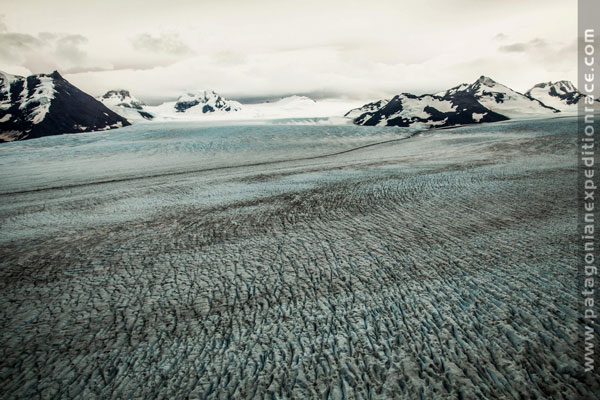 |
helicopter view of 2 teams on the Tyndall Glacier (PER pic)
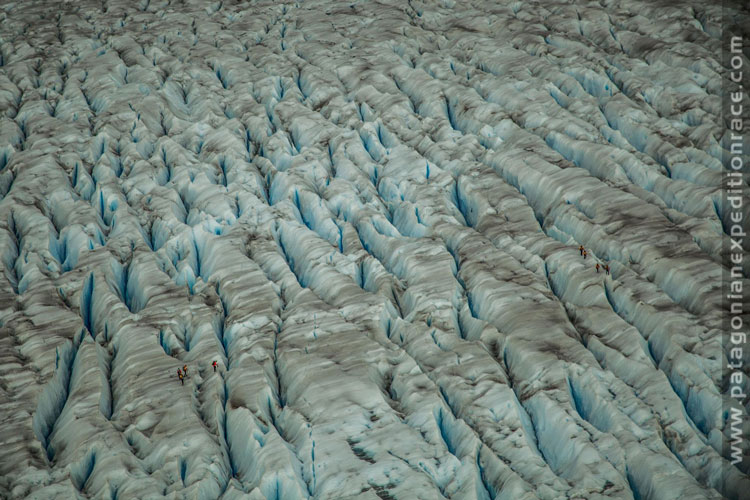 |
Raquel on the glacier
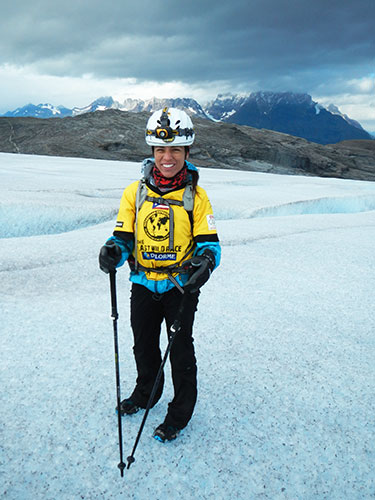 |
Sam crosses a crevasse
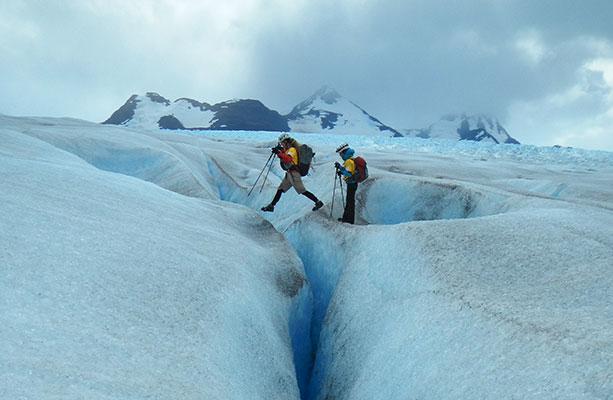 |
Taz admires the view while Sam and Raquel skirt a crevasse
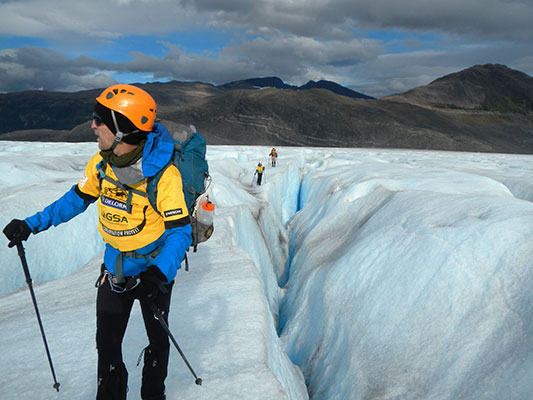 |
deteriorating conditions in the evening (Sam pic)
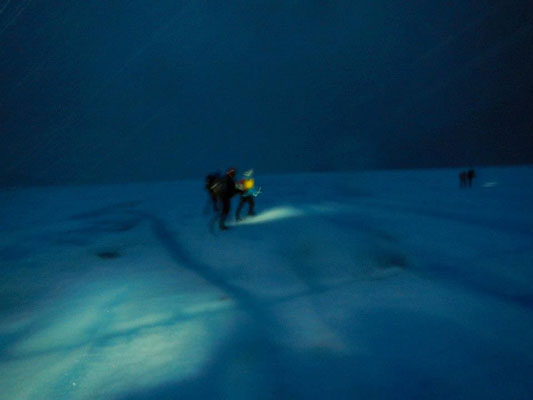 |
The next morning it took a bit to unfold ourselves from the tent. Then we searched around the jumbled ice and crevasse land to a number of dead ends before deciding to head down the clearer ice towards the center of the glacier farther south and then turn towards the checkpoint. This was a good plan, and where we turned west we saw others walking towards us. It turns out this was all the people at cp3 as well as the teams that made it there that morning and were heading back. We were within 20 minutes of it at that point when we turned back for another 5 plus hour trek across the ice. It was really cool and impressive, but we were ready to be off it. We did manage to stop for a few pictures (doing some acrobatics, taking pictures, and jumping over crevasses). Back off the ice we proceeded back down to the river crossing where we camped that night. More hot food and 9 plus hours fully horizontal on our klymit mats made a big improvement in our energy level. I was starting to become a zombie before that.
our camp on the glacier
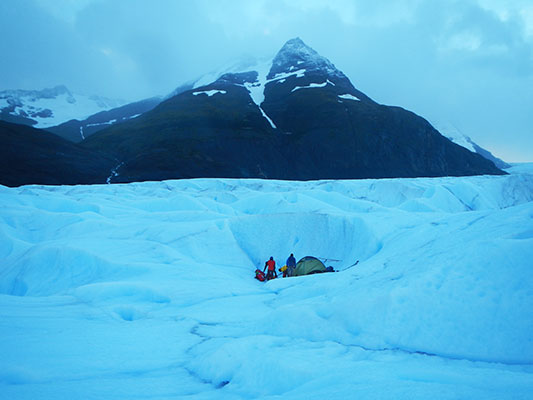 |
mmm hot breakfast (Sam? pic)
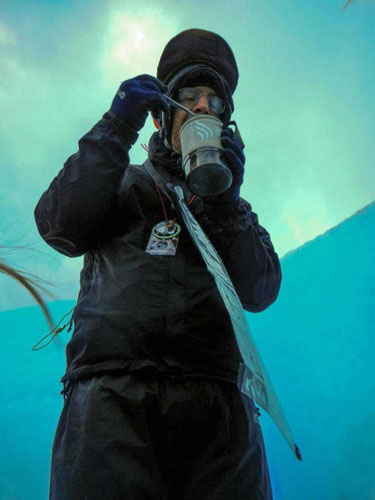 |
massive doline on the Tyndall Glacier - big enough to hide a house
 |
trying to find a way through crevasse land (Taz? pic)
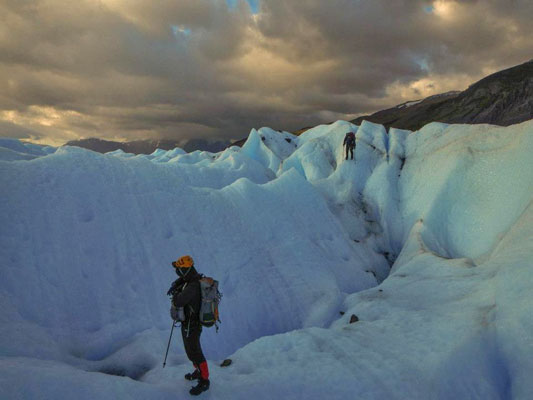 |
self portrait on the glacier
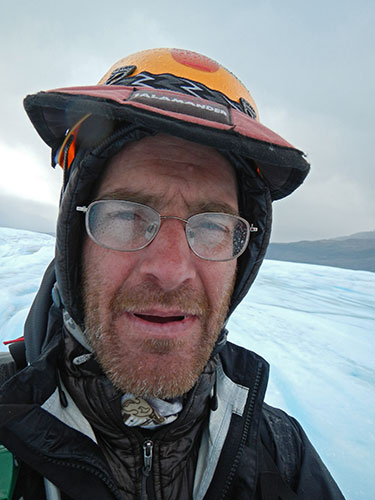 |
38.3 mph - we measured up to 47 in the morning, but there were stronger gusts (Sam pic)
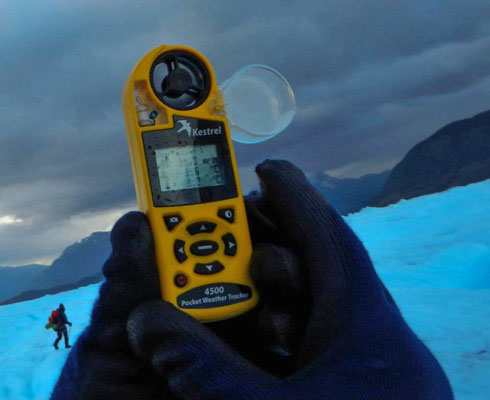 |
back on solid ground (Taz? pic)
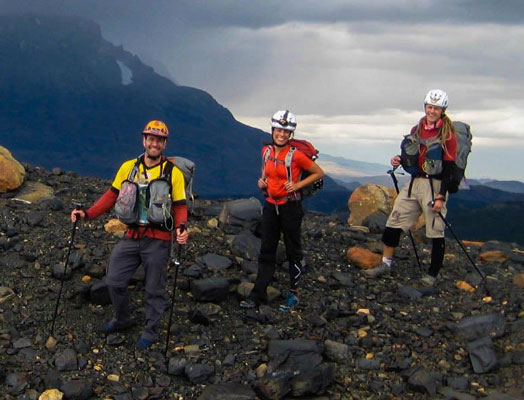 |
the side of the Tyndall Glacier - dropping into a lake
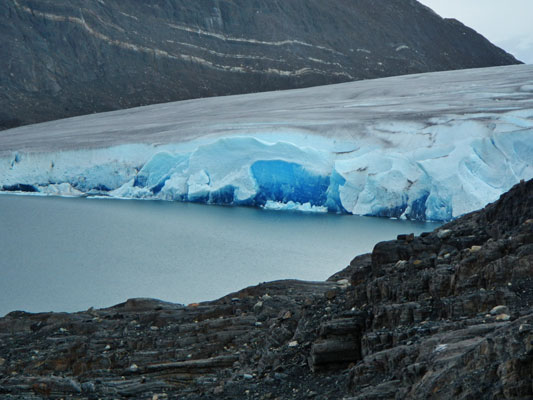 |
The next morning we weren't in any particular hurry which was good because we were all moving a little slow. We did some foot surgery, ate breakfast, and packed up the tent in a leisurely fashion. We just had to make it back to the ranger station at the end of the road before 4 pm. It was nice not to be pressed for time, but we still had a decent distance to go. I managed to rock hop across the stream, but the others waded across not as dry for the feet but probably a lot safer. There were heaps of rainbows in the morning - which means it was raining some of the time. Later we took a detour to look at Pingo Falls - which was quite impressive, but that was just the rapids leading up to the falls. The trail to the falls continued on downhill away from the trail but was well worth it with a heap of water and a rainbow in the spray. Once again I was missing my dslr, although not the weight of carrying it.
In the tent that night - tired campers by PER, light by Fenix, hot water by Jetboil, and tasty dinner by Alpine Aire
 |
sewing a strand of thread through a blister
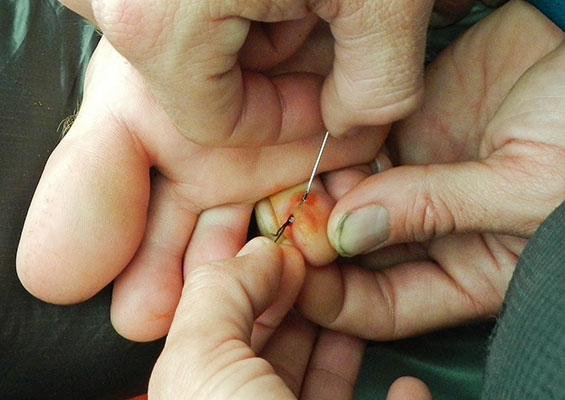 |
stream crossing in the rain
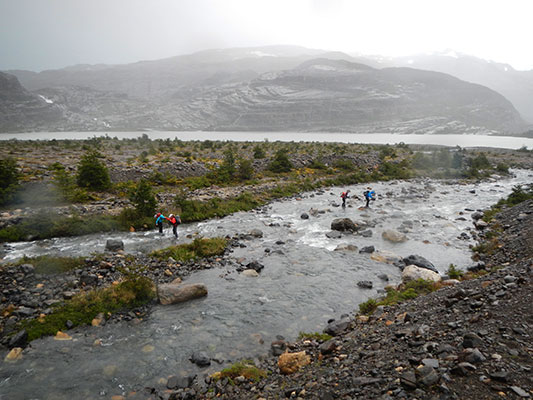 |
Taz and Valentina crossing the stream
 |
there were lots of rainbows
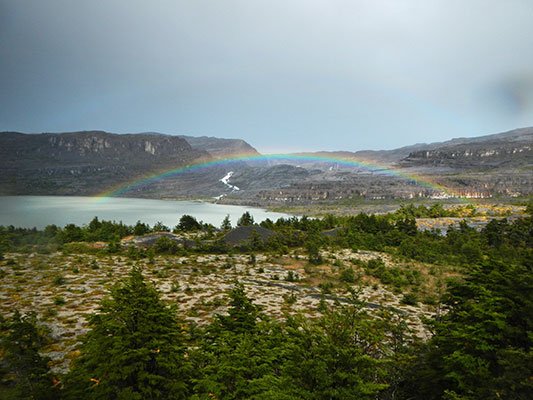 |
we thought this was Pingo Falls, in camera panorama
 |
Pingo Falls with rainbow
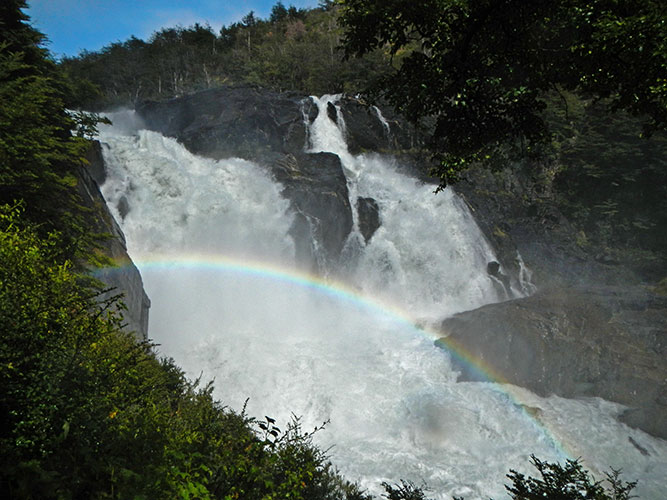 |
Back on the trail there were some Chileans taking a break. Their packs probably weighed twice what ours did but they were still tromping on as fast as we were. One even had a bug bite or bee sting over his eye. It definitely put being tough in perspective.
bee sting or bug bite, Abelardo of team Kaweskar
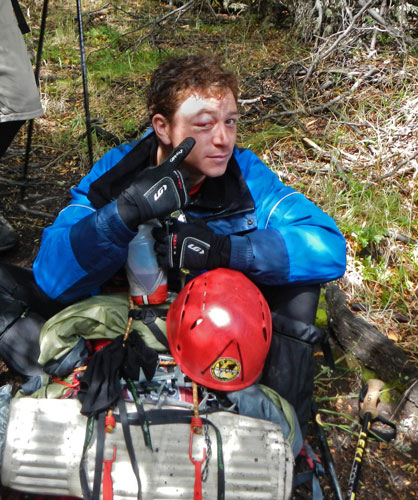 |
enchanted forest
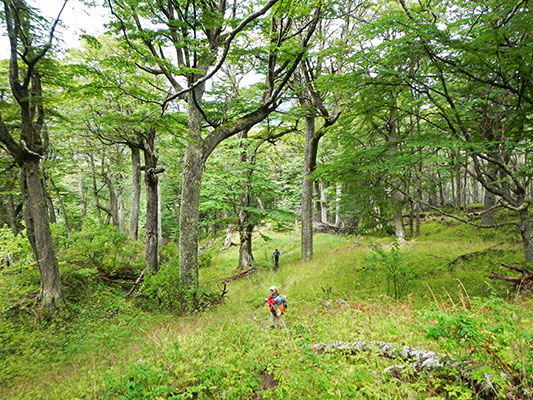 |
Taz and Sam take a break on a bridge
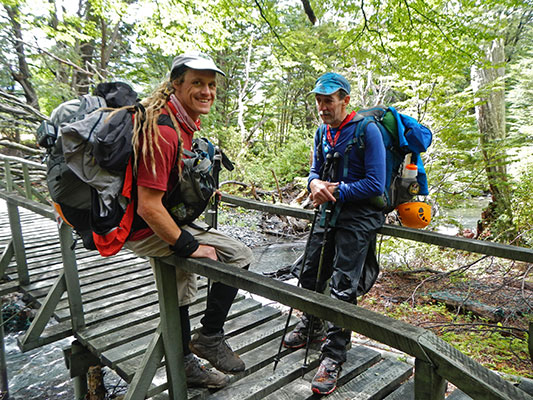 |
Raquel is pretty happy to see the flag at the ranger station
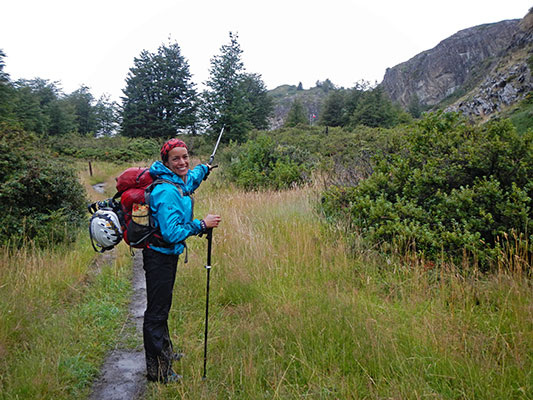 |
we made it back to the ranger station where CP1 had been around 3:40 - perfect timing had the bus come at 4. However that was not the case and Brian's satellite phone had dead batteries. Luckily the DeLorme inreach was still functioning and with that he was able to communicate and arrange for transportation. It was still going to be a while. Unfortunately we were all wet and it was getting cold when we were just sitting there. Once we realized that we were going to be waiting a while some of us went to look at Lago Gray. There were a few icebergs sitting on the beach but we couldn't see the surrounding mountains or the glacier at the head of the lake. It was also starting to rain again. We also saw a parrot in the top of a tree. I wandered around the area taking some pics of the old wagon and a lichen covered skull and tried to stay warm. Finally a bus came and we all piled in. Dinner was cheese, meat, and white bread sandwiches that were constructed and passed around. They dropped us off at an army base and we took over an empty barracks. The gang showers were pretty chilly by the time I got into them, but it was nice to scrub off. One cool thing about spending the night crammed in a tent and waiting for the bus and the stay in the barracks was we got to know the Chilean teams better, especially Kaweskar - the team we shared the tent with. The next morning we walked to the end of the barrack road and waited for another bus which took us back to Punta Arenas.
back at the end of the road with the Chilean team Kaweskar (Alexandre Buisse pic)
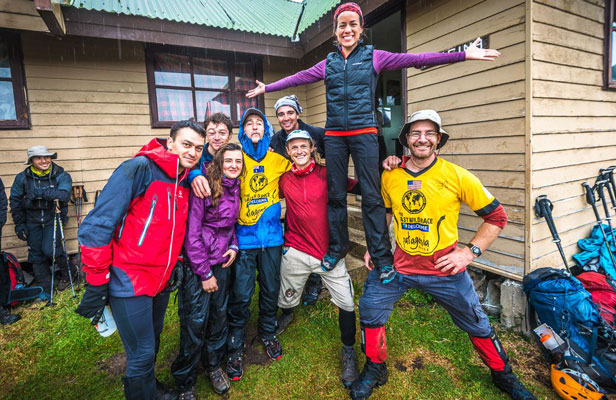 |
Team Four Continents and our packs
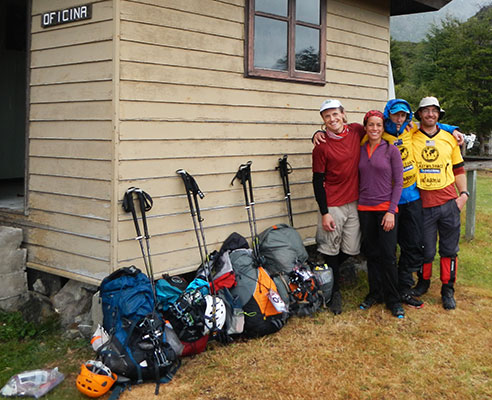 |
our packs
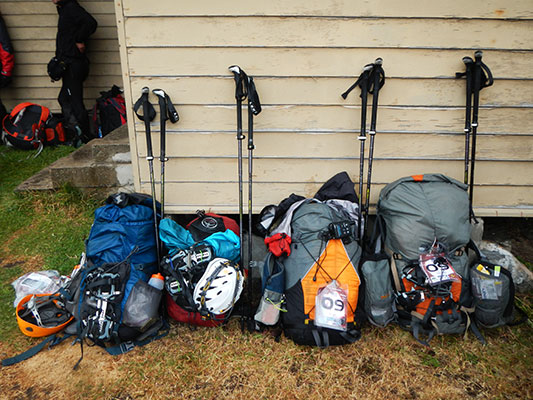 |
lichen covered skull
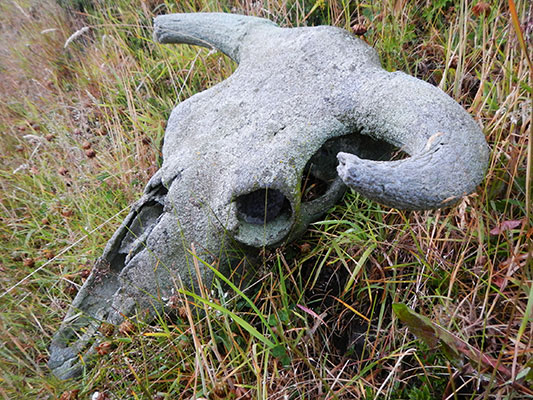 |
Valentina trying to stay warm while waiting for the bus
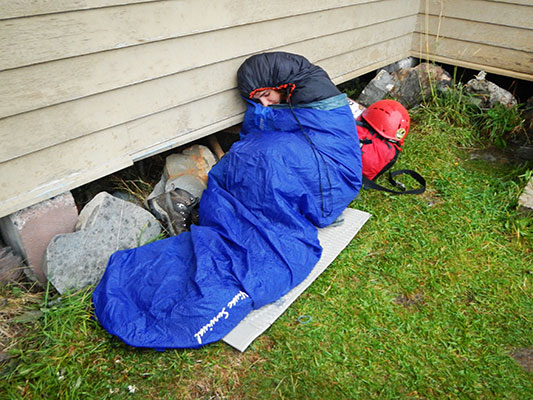 |
if you don't have dry boots you can use plastic bags
 |
a little acro in the army barracks
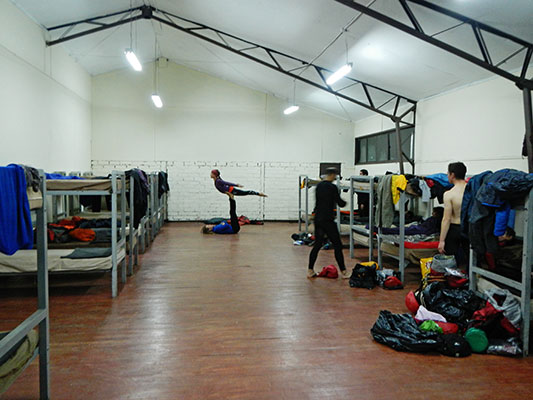 |
hiking down the road for the bus
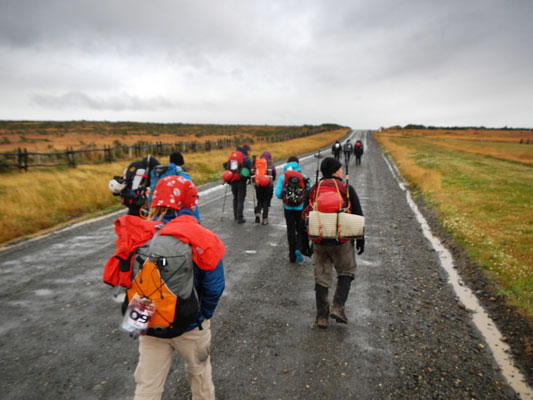 |
There were many things that contributed to our being eliminated so quickly in this race. For one, the cutoff times were pretty fast, In fact before the end of the second day all but 3 (out of 11) teams had been eliminated and I think only 2 teams managed to make all the cutoff times. This is supposed to be the toughest race in the world, but I would have preferred to have been beaten by Patagonia, not the stopwatch, or at least be able to go a few more days. Another factor was that we didn't train as a team. This hurt us on the biking because we weren't used to riding in a group together or towing and we wasted some time discussing who would carry what and so on. Probably the biggest factor was we just weren't in good enough shape. While I think I succeeded in my training goal of not being the weakest link, I wasn't able to power up the hills and carry more weight when others were lagging. Also the towing on the bicycle really hurt me, I was pretty beat when we got to CP1, and I never really recovered. Finally I think I did a decent job of navigating to the glacier, but I failed in finding a way off in the middle of the night. Had I known which way to go I would have argued that we should keep going and we would probably have been able to continue on past CP3. I wish I had known about the DeLorme aerial photos since they were so much better than what Google had for the glacier - I looked there before the race, but with the DeLorme I might have been able to pick a better route the first time.
The race was quite spectacular and it is tempting to want to head back to try again, but knowing my pace and the cutoff times it doesn't really make any sense for me to go through the significant effort and expense to get down there only to be eliminated by the clock. Of course in time I might forget that and only remember how spectacular it was, or maybe I'll get faster in my old age.
Many people and entities helped us make it to this race, and I would like to thank them here. I probably forgot some, but here they are in no particular order...
Leki trekking poles, Fenix lights, Kahtoola crampons, Aarn packs, Royal Hawaiian macadamia nuts, Prana clothing, Tailwind Nutrition, Journey Bars, Ellsworth Bicycles, Inov8 shoes, Toesox, Jorge and Catalina, Jorge (at Victoria Hostel), Rodrigo and Andrea, The rest of the Team Four Continents - Taz, Raquel, and Sam, the other YogaSlackers team - Chelsey, Jason, Dan, and Paul, JetBoil, Geigerrig hydration, Dad, Macpac Packs, Julie, Ian and Family, Amy, Pete, Bodyglove/Surge, Kokatat, Lizard footwear, Ibex, Wenger, Klymit, Mike, Alpine Aire, and Sterling Ropes. I am sorry if I have forgotten to include you, thanks whoever you are.
Here are some links that may be of interest:
Getting to Punta Arenas
This series of blog posts was nimbly thumbed out on an iphone by Raquel and details some of our travails in getting to the race - a full on adventure in itself
#1 International Travel on Standby
#2 On buying a car in Chile
#3 Car trouble
#4 On selling a car in Chile NOT
#5 Please sell me a bus ticket
#6 Bike box tale
#7 What to do in bus station
#8 Bus bike box and truck
#9 Flying with style
The Race
Here are some more blog posts of the race thumbed out by Raquel.
How exploding tires and gravel roads almost cost us the race
The trek to the Magnificent Glacier and finally doing something right!
Sleeping on Ice
our camp on the Tyndall Glacier - note the fresh snow on the mountain
 |
No material on this page may be copied or used without permission.























